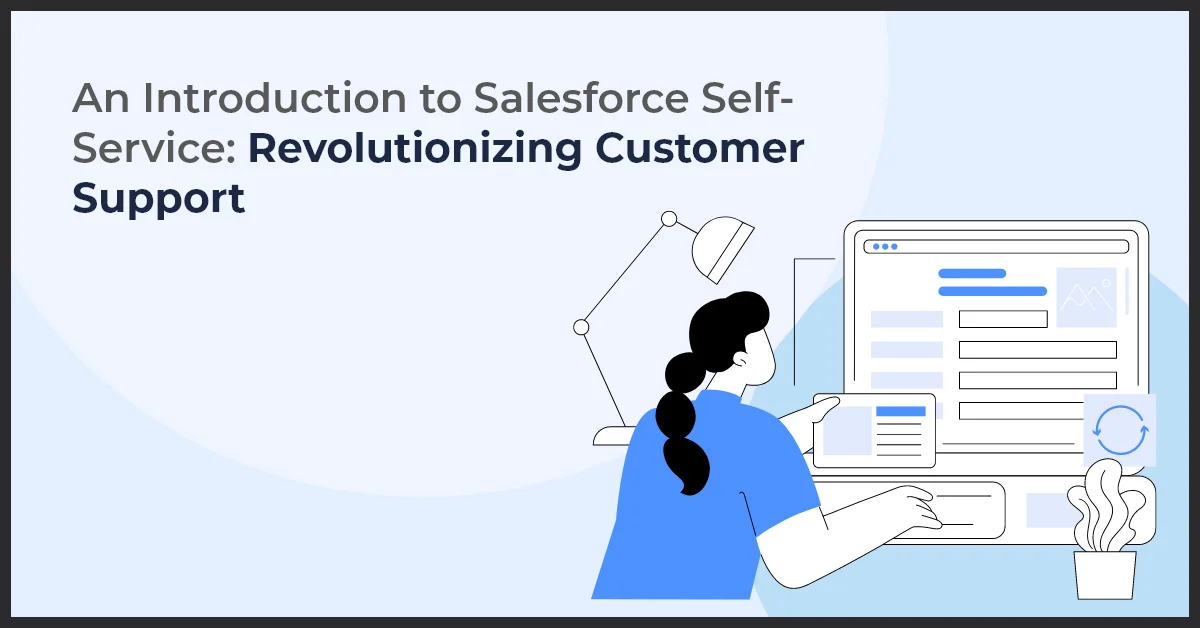An Introduction to Salesforce Self-Service: Revolutionizing Customer Support

Published on: October 30, 2023
Updated on: September 18, 2024
1864 Views
- Salesforce
11 min read
In today's digitally-driven world, self-service portals have become the cornerstone of exceptional customer support. These portals empower customers to find the information they need without the need for extensive assistance from support agents. And when it comes to self-service, Salesforce is the name that shines in the crowd.
Salesforce self-service is a powerful solution that provides customers with a user-friendly platform to access and resolve their queries independently. By offering a comprehensive knowledge base, FAQ sections, forums, and interactive tutorials, Salesforce self-service streamlines the customer support process while delivering numerous benefits.
Firstly, it enhances the customer experience by empowering them to find answers and solutions anytime, anywhere. With Salesforce self-service, customers no longer have to wait for support agents to respond to their queries. They can easily access relevant information, troubleshoot problems, and learn new features at their own convenience.
Furthermore, self-service significantly reduces support costs for businesses. As customers find resolutions themselves, fewer support tickets are generated, resulting in decreased workload for support teams. With fewer resources dedicated to repetitive queries, companies can allocate their support budget towards more complex issues and personalized customer interactions.
Discover the power of Salesforce self-service and unlock a new dimension of customer support efficiency. Empower your customers, streamline your support process, and witness the transformative impact of self-service in driving customer satisfaction and reducing costs.
Self-Service Portals
A self-service portal is an online platform that allows customers to find answers to their questions, troubleshoot issues, and access resources without having to rely on customer support representatives. These portals play a crucial role in providing efficient customer support and improving overall satisfaction.
By offering self-service options, businesses can empower their customers to find information and resolve problems on their own, at their convenience. This not only reduces the workload on customer support teams but also gives customers a sense of control and independence in managing their interactions with the company.
Self-service portals commonly feature knowledge bases, which store a wealth of information about products, services, troubleshooting guides, and frequently asked questions (FAQs). Customers can search and access relevant articles or guides, helping them quickly find the answers they need.
In addition to knowledge bases, self-service portals often provide search functionality, allowing users to type in keywords or phrases to locate specific information. This feature streamlines the process of finding relevant resources and improves the overall user experience.
Having a self-service portal also enables businesses to offer interactive elements like forums or communities where customers can share their experiences and exchange knowledge. This fosters a sense of community and collaboration among customers, enhancing their overall satisfaction.
Overall, self-service portals enhance customer satisfaction and convenience by providing easy access to information, reducing response times, and promoting customer autonomy. By investing in the development and optimization of self-service portals, businesses can significantly improve their customer support and elevate the customer experience.
Setting up the Salesforce Self-Service Portal
Learn how to enable and configure a self-service portal within Salesforce with this step-by-step guide.
- Step 1: Login to your Salesforce account and navigate to the Setup section.
- Step 2: In the Setup menu, search for "Self-Service" and click on "Self-Service Portal Settings".
- Step 3: Enable the self-service portal by toggling the switch to "On".
- Step 4: Customize the portal's branding to match your company's website or branding guidelines by uploading a logo and choosing color schemes.
- Step 5: Consider integrating the self-service portal with other Salesforce modules, such as case management and ticketing systems, to streamline customer support processes.
By following these steps, you can easily set up and configure the Salesforce Self-Service Portal to enhance your customer support capabilities.
Chatbots and Virtual Assistants in Self-Service
Chatbots and virtual assistants play a crucial role in enhancing the self-service experience. By providing personalized and automated support to customers, these intelligent tools can streamline the customer service process and significantly improve customer satisfaction.
Salesforce offers a range of chatbot capabilities and integration options that can be seamlessly incorporated into your self-service portal. These chatbots can be programmed to handle various customer queries, provide relevant information, and even perform certain tasks, all without the need for human intervention.
Implementing chatbots in your self-service portal allows for round-the-clock support, ensuring that customers can access assistance whenever they need it. Additionally, chatbots can provide instant responses, minimizing wait times and increasing customer convenience.
To ensure a successful chatbot implementation, it is essential to consider the following suggestions:
- Define clear objectives: Identify specific goals and outcomes you want to achieve with chatbot integration. This will help you establish metrics for measuring success.
- Train the chatbot: Invest time in training the chatbot to understand customer queries accurately and provide relevant responses. Regularly update the chatbot's knowledge base to keep it up-to-date.
- Offer personalized interactions: Utilize customer data to provide personalized recommendations and customized experiences through the chatbot. This will enhance customer satisfaction and build strong relationships.
- Integrate with CRM: Integrate your chatbot with Salesforce CRM to access customer data and provide personalized support based on past interactions and preferences.
By implementing chatbots in your self-service portal, you can deliver efficient and effective customer support while reducing the workload on your service agents. Customers will appreciate the instant assistance and personalized experiences, leading to increased satisfaction and loyalty.
Enhancing Customer Support with Self-Service
In today's fast-paced and digital world, customers expect quick and efficient support from businesses. This is where self-service portals come into play, complementing traditional customer support channels and providing a seamless customer service experience.
How self-service portals complement traditional customer support channels
Self-service portals empower customers to find answers to their questions and solutions to their problems without the need to contact a support representative. By offering a comprehensive knowledge base and an easy-to-navigate interface, businesses can reduce the dependency on phone calls and emails, allowing their support teams to focus on more complex issues.
Moreover, self-service portals provide round-the-clock availability, allowing customers to seek assistance at their own convenience. This eliminates the frustration and wait times often associated with traditional support channels, resulting in increased customer satisfaction.
Tips for encouraging customers to use the self-service portal and reducing support ticket volume
Implementing self-service portals is not enough; it is essential to actively encourage customers to take advantage of this efficient support option.
Here are some tips:
- Promote the benefits: Clearly communicate the advantages of using the self-service portal, such as instant access to information, 24/7 availability, and faster issue resolution.
- Make it user-friendly: Ensure the self-service portal is intuitive and easy to navigate, with a search function and clear categorization for easy information retrieval.
- Create engaging content: Develop informative and engaging articles, FAQs, and video tutorials that provide valuable insights and solutions to customer issues.
- Offer incentives: Provide incentives for customers to use the self-service portal, such as exclusive discounts or rewards for successfully resolved issues.
By actively encouraging customers to use the self-service portal, businesses can significantly reduce support ticket volume, allowing their support teams to focus on more complex and critical customer needs.
Case studies or success stories demonstrating the positive impact of self-service on customer support efficiency
Several businesses have already experienced the positive impact of implementing self-service portals. Here are a few success stories:
- Company XYZ: By implementing a self-service portal, Company XYZ saw a 40% decrease in support ticket volume within the first month. Customers appreciated the quick access to information and reported higher satisfaction levels.
- Company ABC: Company ABC's support team was overwhelmed with a high volume of phone calls and emails. After introducing a self-service portal, they witnessed a 50% decrease in support ticket volume, allowing their support agents to focus on complex cases and improving response times.
These case studies highlight the efficiency and effectiveness of self-service portals in enhancing customer support and business operations.
Measuring Self-Service Effectiveness
Measuring the effectiveness of your Salesforce self-service portal is crucial in evaluating its success and identifying areas for improvement. By monitoring key metrics and utilizing customer feedback and analytics, you can continuously enhance the self-service experience. Here are some strategies and recommended Salesforce reports to help measure the effectiveness of your self-service portal:
Key Metrics and Indicators
- Self-Service Usage: Measure the number of customers accessing and utilizing the self-service portal. This metric indicates the level of adoption and effectiveness of the portal.
- Self-Service Case Deflection: Track the percentage of cases that are successfully resolved through the self-service portal without the need for additional customer support. This metric quantifies the portal's ability to reduce the workload on your support team.
- Customer Satisfaction: Gather customer feedback through surveys or ratings to evaluate their satisfaction with the self-service experience. This metric provides insights into the overall effectiveness and customer perception of the portal.
Recommended Salesforce Reports and Dashboards
Salesforce offers various powerful reporting and dashboard features to monitor and analyze the performance of your self-service portal.
Some recommended reports and dashboards include:
- Self-Service Usage Report: Provides an overview of self-service usage, including the number of logins, knowledge article views, and cases created through the portal.
- Knowledge Base Report: Analyzes the performance of your knowledge base by tracking article views, ratings, and feedback. This report helps identify popular articles and areas for improvement.
- Case Deflection Report: Measures the percentage of cases resolved through self-service without agent intervention, allowing you to gauge the portal's impact on reducing support workload.
Leveraging Customer Feedback and Analytics
Collecting and analyzing customer feedback and analytics is crucial for continuously improving the self-service experience.
Here are some strategies to leverage this data:
- Surveys and Feedback Forms: Implement surveys and feedback forms within the self-service portal to gather customer feedback on their experience. Use this data to identify pain points and areas for improvement.
- Knowledge Base Analytics: Analyze knowledge base usage analytics to identify popular articles, frequently asked questions, and areas where customers might be encountering difficulties.
- Case Analysis: Review cases that were escalated from self-service and identify common issues or gaps in knowledge base content. This helps optimize the knowledge base and enhance the self-service experience.
By diligently measuring the effectiveness of your Salesforce self-service portal and leveraging customer feedback and analytics, you can continually enhance the self-service experience, increase customer satisfaction, and drive business success.
Optimizing the Customer Experience
The role of self-service in optimizing the overall customer experience:
Self-service plays a crucial role in enhancing the customer experience by empowering customers to find solutions to their problems independently. By offering a self-service portal, businesses can provide round-the-clock support, reducing the waiting time for customers and increasing their satisfaction levels. Whether it's accessing knowledge articles, troubleshooting guides, or FAQs, self-service portals enable customers to get instant answers to their queries, making their experience seamless and efficient.
Integration possibilities with other Salesforce modules, such as CRM and case management, to provide personalized support:
When integrated with other Salesforce modules like CRM and case management, the self-service portal becomes even more powerful in optimizing the customer experience. By connecting customer data from various touchpoints, businesses can personalize the self-service experience based on the customer's past interactions, preferences, and purchase history. This enables businesses to provide targeted, relevant information to customers, making them feel valued and enhancing their overall experience with the brand.
Tips for continuously optimizing the self-service portal based on customer feedback and evolving customer needs:
- Regularly collect and analyze customer feedback: Regularly solicit feedback from customers who have used the self-service portal to identify any pain points or areas for improvement. This feedback, coupled with data analytics, can help businesses uncover new insights and make necessary tweaks to enhance the portal's usability and functionality.
- Monitor customer behavior and trends: Continuously track customer behavior on the self-service portal to identify patterns and trends. This data can help businesses proactively address common customer issues by optimizing the portal's content, structure, and navigation.
- Keep up with evolving customer needs: Customer needs and preferences are ever-changing. Businesses should stay updated with market trends, technology advancements, and customer expectations to ensure the self-service portal remains relevant and valuable. Regularly update the portal's content and features to reflect these changing needs.
Conclusion
Throughout this series, we have explored the vast benefits and importance of Salesforce self-service portals. From streamlining customer support to reducing costs, self-service portals have proven to be a game-changer for businesses of all sizes. By empowering customers to find answers and resolve issues on their own, businesses can save time and resources while providing a seamless experience.
Final thoughts on the future of self-service and its impact on customer support and satisfaction
As technology continues to advance, the future of self-service looks promising. With the rise of artificial intelligence and machine learning, we can expect self-service portals to become even more advanced and intuitive. Chatbots and virtual assistants will play a crucial role in enhancing the self-service experience, providing instant and personalized support to customers.
Call-to-action for businesses to implement or enhance Salesforce self-service for better customer experiences
It is time for businesses to embrace the power of Salesforce self-service portals. By implementing or enhancing self-service capabilities, businesses can enhance customer experiences, build brand loyalty, and improve customer satisfaction. Don't miss out on this opportunity to revolutionize your customer support and stay ahead of the competition.
Frequently Asked Questions
Salesforce Self-Service benefits customers by providing them with immediate access to information and support, reducing wait times, and offering a convenient way to resolve issues 24/7. It empowers customers to find solutions quickly and efficiently.
Self-service CRM empowers users to manage their customer relationships independently. It enables customers to access information, update profiles, and resolve issues autonomously, enhancing efficiency and customer satisfaction.
A Salesforce Knowledge Base is a repository of articles and information that provides answers to common questions and issues. It allows customers and support agents to find and share knowledge quickly, improving support efficiency.
Salesforce Self-Service offers features such as a knowledge base, community forums, case deflection, and AI-powered chatbots. The knowledge base contains articles and FAQs that address common customer inquiries, while community forums allow customers to collaborate and share information. Case deflection uses intelligent algorithms to suggest relevant articles to customers based on their inquiries, and AI-powered chatbots provide real-time assistance.
Salesforce Self-Service uses AI to power chatbots that can handle routine inquiries and provide instant responses. Automation tools can help route complex issues to the appropriate support team, track case progress, and suggest relevant knowledge base articles to customers.



